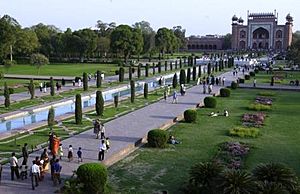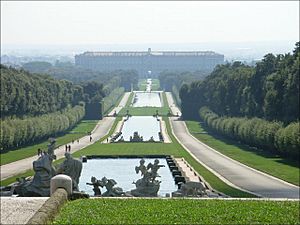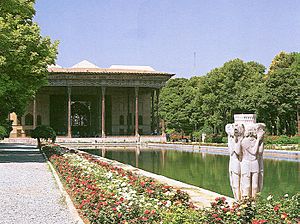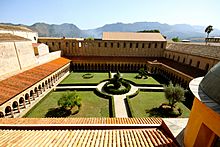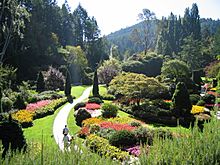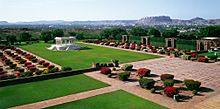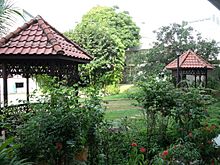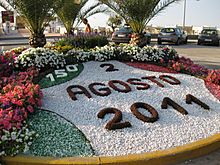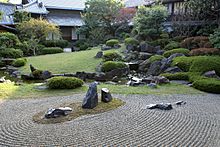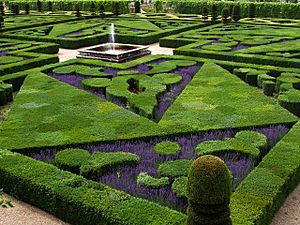Garden facts for kids
A garden is a special outdoor area. It is designed for showing, growing, and enjoying plants and other parts of nature. Gardens can have natural things like plants and rocks, and also things made by people, like paths or statues. Most gardens you see today are residential gardens, which are found at homes. But the word "garden" can mean many things. For example, Zoos, where you see wild animals in places that look like their natural homes, used to be called zoological gardens. In many Western countries, gardens are mostly about plants. The word "garden" often refers to a smaller version of a botanical garden.
Some traditional gardens, like Zen gardens in the East, use very few plants or no plants at all. Xeriscape gardens are smart! They use local plants that don't need much water or other resources. This helps save water while still making a beautiful garden. Gardens can also have special structures called follies. These might include water features like fountains, ponds (with or without fish), waterfalls, or even dry creek beds. You might also see statues, arbors, or trellises in a garden.
Some gardens are just for looking at and enjoying their beauty. Other gardens also grow food, like vegetables or herbs. Sometimes, these food plants are in a separate area. Other times, they are mixed in with the pretty ornamental plants. Gardens that grow food are usually smaller than farms. They also involve more hands-on work. People grow food in gardens as a hobby, not usually to sell it. Flower gardens combine plants of different heights, colors, and smells. This creates a wonderful place that is interesting and pleasing to your senses.
Gardening is the activity of taking care of a garden. This work can be done by someone who does it for fun (an amateur) or by a professional gardener. A gardener might also work in other places besides gardens. They could work in a park, along a road, or in other public spaces. Landscape architecture is a job where professionals design outdoor spaces for public places or businesses.
Contents
Designing Your Garden Space
Garden design is about making plans for how a garden will look. This includes where things will be placed and what plants will grow there. Garden owners can design their own gardens. Or, they can hire professionals. Professional garden designers know a lot about design and horticulture (the science of growing plants). They also have experience choosing and using different plants. Some garden designers are also landscape architects. This means they have more formal training, often with a special degree.
When designing a garden, many things are considered. This includes where to put paths, rock gardens, walls, and sitting areas. It also involves choosing the right plants. Designers think about what plants need to grow well. They also consider how plants will look throughout the year. They think about how big plants will get and how fast they will grow. They also plan how different plants will look together.
Designers also think about how much work the garden will need. This includes how much time or money is available for regular care. This can affect choices like how fast plants grow. It also influences whether plants spread easily or reseed themselves. They also consider if plants are annual (grow for one season) or perennial (grow back year after year). Garden design can be split into two main types: formal gardens and natural-looking gardens.
The most important thing in garden design is how the garden will be used. After that, people think about the style they want. They also consider how the garden will connect to the house or other buildings nearby. All these ideas depend on the budget. If the budget is small, a simpler garden style can be chosen. This might mean fewer plants or less expensive materials. People might also choose to plant seeds instead of buying grass rolls for lawns. Another idea is to create the garden slowly, one section at a time.
-
The Sunken Garden at Butchart Gardens in Victoria, British Columbia.
-
The famous Gardens of Versailles in France.
-
A tropical garden at the Faculty of Science, National University of Singapore in Singapore.
-
A flower-bed showing the date in Lignano Sabbiadoro, Italy.
-
Gardens at Colonial Williamsburg in Williamsburg, Virginia, with many old plant types.
-
The Shitennō-ji Honbo Garden in Osaka, Osaka prefecture, Japan – an example of a zen garden.
What Makes Up a Garden?
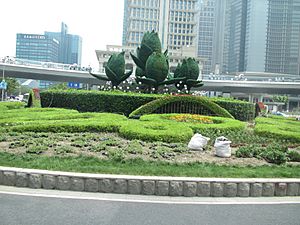
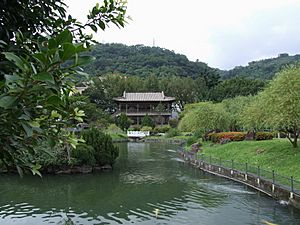

Most gardens have a mix of natural and human-made parts. Even gardens that look very "natural" are still created by people. Natural parts of a garden include plants like trees and weeds. They also include animals like arthropods (insects) and birds. Soil, water, air, and sunlight are also natural elements.
Human-made parts include paths, patios, and sculptures. They can also include drainage systems, lights, and small buildings. These buildings might be sheds, gazebos, or pergolas. Even living things like flower beds, ponds, and lawns are often designed and created by people.
How People Use Gardens
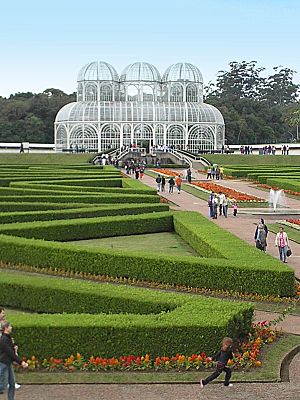
Gardens can be used for many things. They can be beautiful, useful, and fun!
- Working with nature
- Growing plants
- Learning about nature through gardening
- Watching nature
- Relaxing and having fun
- Growing useful things
- Flowers to cut and bring inside
- Fresh herbs and vegetables for cooking
Different Kinds of Gardens

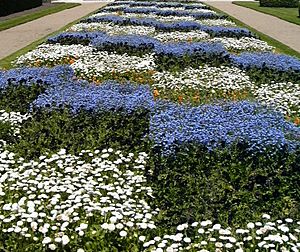
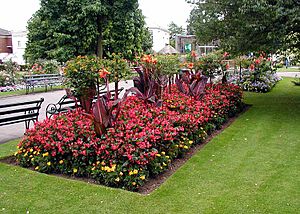

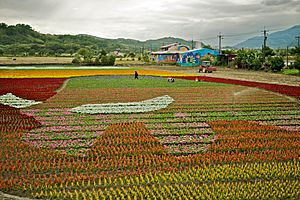
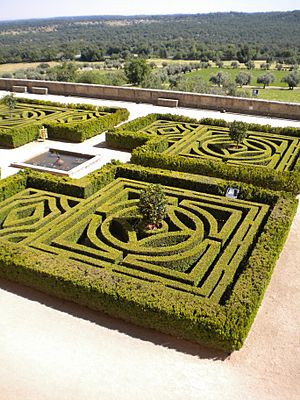
Gardens can be named for the specific plants they feature:
- Back garden
- Bog garden (for plants that like wet soil)
- Cactus garden
- Color garden
- Fernery (for ferns)
- Flower garden
- Front yard
- Kitchen garden (for food plants)
- Mary garden
- Orangery (for citrus trees)
- Orchard (for fruit trees)
- Rose garden
- Shade garden
- Vineyard (for grapes)
- Wildflower garden
- Winter garden
Gardens can also be known for their special style or look:
- Bonsai (miniature trees)
- Chinese garden
- Dutch garden
- English landscape garden
- Gardens of the French Renaissance
- French formal garden
- French landscape garden
- Italian Renaissance garden
- Japanese garden
- Knot garden
- Korean garden
- Mughal garden
- Natural landscaping
- Persian garden
- Roman gardens
- Spanish garden
- Terrarium (a small garden in a container)
- Trial garden
- Tropical garden
- Water garden
- Wild garden
- Xeriscaping (low-water garden)
- Zen garden
Here are some other types of gardens:
- Botanical garden (for studying plants)
- Butterfly garden (to attract butterflies)
- Butterfly zoo
- Chinampa (floating gardens)
- Cold frame garden (for protecting plants)
- Community garden (shared by many people)
- Container garden (plants in pots)
- Cottage garden (informal, traditional style)
- Cutting garden (for flowers to cut)
- Forest garden
- Garden conservatory
- Green wall (plants growing on a wall)
- Greenhouse (a building for growing plants)
- Hanging garden
- Hydroponic garden (growing plants without soil)
- Market garden (for growing food to sell)
- Rain garden (absorbs rainwater)
- Raised bed gardening (plants in raised boxes)
- Residential garden (at a home)
- Roof garden (on a roof)
- Sacred garden
- Sensory garden (designed for all senses)
- Square foot garden (small, efficient garden)
- Vertical garden
- Walled garden
- Windowbox (a small planter for a window)
- Zoological garden (for animals)
How Gardens Affect the Environment
Gardeners can sometimes impact the environment. This can happen through their gardening choices. However, they can also help improve their local environment.
Sometimes, creating gardens can lead to destroying natural habitats. This happens when land is cleared for houses and gardens. Also, getting materials for gardens, like peat or rocks, can harm natural areas. Using too much tap water for irrigation can also affect wetlands. Some gardening products, like slug killers, can harm animals beyond just slugs and snails. They can also hurt animals that eat slugs, like hedgehogs.
Watering Your Garden
Some gardeners are very careful about water. They manage their gardens without using any water from outside their property. This helps protect natural wetland habitats. For example, some gardens in Britain, like Ventnor Botanic Garden, use very little outside water.
Rain gardens are a clever way to manage water. They soak up rainwater from nearby hard surfaces. This stops the water from going into storm drains. For watering plants, people use different methods. These include collecting rainwater, using sprinkler systems, or drip irrigation. Some also use tap water, greywater (recycled household water), hand pumps, or a watering can.
Related Pages
Images for kids
-
Autumn colors at Stourhead landscape garden are beautiful, even without many flowers.
-
A recreated garden from the House of the Vettii in Pompeii.
-
Parc de Bagatelle, a lovely rose garden in Paris.
-
A typical Italian Renaissance garden at Villa Garzoni, near Pistoia.
-
Hatanpää Arboretum in Hatanpää, Tampere, Finland.
See also
 In Spanish: Jardín para niños
In Spanish: Jardín para niños


